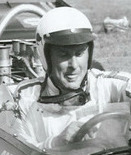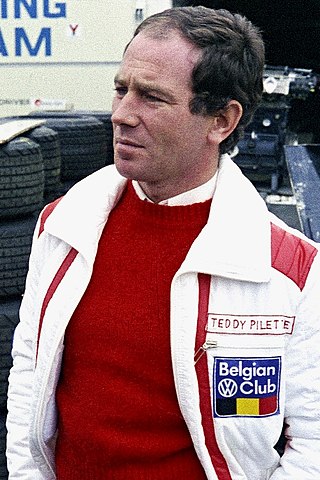Robert Brett Lunger is an American racecar driver.

Peter Kenneth Gethin was a British racing driver and motorsport executive, who competed in Formula One from 1970 to 1974. Gethin won the 1971 Italian Grand Prix with BRM.

Repco is an Australian automotive engineering/retailer company. Its name is an abbreviation of Replacement Parts Company and was for many years known for reconditioning engines and for specialised manufacturing, for which it gained a high reputation. It is now best known as a retailer of spare parts and motor accessories.

Graham Peter McRae was a racing driver from New Zealand.

Theodore "Teddy" Pilette is a former racing driver from Belgium. He participated in 4 Formula One World Championship Grands Prix, the first on 12 May 1974 with Bernie Ecclestone's Brabham team.

Formula 5000 was an open wheel, single seater auto-racing formula that ran in different series in various regions around the world from 1968 to 1982. It was originally intended as a low-cost series aimed at open-wheel racing cars that no longer fit into any particular formula. The '5000' denomination comes from the maximum 5.0 litre engine capacity allowed in the cars, although many cars ran with smaller engines. Manufacturers included McLaren, Eagle, March, Lola, Lotus, Elfin, Matich and Chevron.

Chevron Cars Ltd. is an English manufacturer of racing cars, founded by Derek Bennett in 1965. Following Bennett's death in 1978, the firm has remained active in various guises. The original company's designs and name continue to be used to build replacement parts and continuation models of earlier Chevrons. In 2000, Chevron Racing Cars Ltd., founded by Vin Malkie acquired the trade mark Chevron Racing Cars Ltd and in addition to the company's other activities has designed and built new grand tourer racing cars under the Chevron name, as well as other continuation models of earlier Chevrons.
Graeme Harry Lawrence is a race car driver from New Zealand. He started serious motor racing in the National 1.5 litre series winning the series decisively in 1968 ahead of David Oxton and Ken Smith. Lawrence then ran half a European F2 series in an uncompetitive semi works F2 McLaren, he found the racing harder than expected and was shaken, by his experience racing in Germany at the Hockenheim race in the rain, were Jim Clark was killed. McLaren allowed Lawrence to build up another F2 chassis in his works and was 2nd in the SR Gold Star series in the car, and first ST driver home in the Tasman races at Pukekohe and Levin.
Frank GardnerOAM was a racing driver from Australia. Born in Sydney, he was best known for touring car racing, winning the British Saloon Car Championship three times, and sports car racing driver but he was also a top flight open wheeler driver. He was European Formula 5000 champion, and participated in nine World Championship Formula One Grands Prix, debuting on 11 July 1964. He scored no championship points. Gardner also participated in numerous non-Championship Formula One races and his results included a third placing at the 1965 Mediterranean Grand Prix at the Autodromo di Pergusa in Sicily, fourth in the 1965 Race of Champions at Brands Hatch and third in the 1971 International Gold Cup at Oulton Park. He participated each year in the open wheeler Tasman Series held in New Zealand and Australia during the European winter, and shared the grids with the likes of Jim Clark, Graham Hill and Jochen Rindt and won the New Zealand Grand Prix.
The Rothmans International Series was an Australian motor racing series which was staged annually from 1976 to 1979. Initially open to Australian Formula 1 cars, for the final year it was for ‘’Australian Formula 5000’’, ‘’World Formula 1’’ and ‘’Australian Formula Pacific’’ cars.
John McCormack is a former Australian racing driver. Originally from Burnie, Tasmania, McCormack became one of the leading Formula 5000 racers in Australia during the 1970s.
The 1972 Tasman Series was a motor racing competition staged in New Zealand and Australia for racing cars complying with the Tasman Formula. The series, which began on 8 January and ended on 27 February after eight races, was the ninth annual Tasman Series. It was won by Graham McRae of New Zealand, driving a Leda GM1 Chevrolet.
The 1974 Tasman Series was an international motor racing competition which commenced on 5 January and ended on 23 February 1974 after eight races. The championship, which was the eleventh Tasman Championship, was open to Racing cars complying with the Tasman Formula. The winner was awarded the Tasman Cup.

The Lola T332 was a race car designed and built by Lola Cars for use in Formula 5000 racing and made its racing debut in 1973. The T332 was successful around the globe with race victories in places such as Australia, the United Kingdom, New Zealand and the United States. The Lola commonly used the 5.0-litre Chevrolet V8 engine, though some competitors in Australia and New Zealand used the slightly cheaper and less powerful Australian made 5.0-litre Repco Holden V8.

The 19th International Gold Cup was a non-championship Formula One race, which was held on the Oulton Park circuit, located near Tarporley, Cheshire, England on 29 May 1972.

The Chevron B28 was an open-wheel race car, designed, developed and built by British Manufacturer Chevron, for Formula 5000 racing, in 1973. It was driven by Peter Gethin, Teddy Pilette, Vern Schuppan, and Chris Craft. Briton Peter Gethin won 4 races in the 1974 season with the B28, eventually finishing second place, as runner-up in the championship, with 186 points. Gethin's Belgian teammate, Teddy Pilette, would finish fourth place in the championship, with 108 points. Chevron only produced two finished models of the B28. It did compete at the non-championship Race of Champions Formula One race, being driven by Peter Gethin, and its best result there was a 10th-place finish. It was later converted into a closed-wheel prototype-style car, and used in the revived Can-Am series in North America. As with most other cars of the time, it was powered by the commonly used Chevrolet small-block engine.

The 8th Race of Champions was a non-Championship motor race, run to Formula One rules, held on 18 March 1973 at Brands Hatch circuit in Kent, UK. The race included several entrants in Formula 5000 cars and was won by Peter Gethin in a Chevron-Chevrolet B24 '72-05'. This was the only race other than the poorly-attended 1969 Madrid Grand Prix in which a Formula 5000 car beat a Formula One car.
The 1973 Rothmans 5000 European Championship was a motor racing series for Formula 5000 cars. The series was organized in the United Kingdom by the British Racing and Sports Car Club but also incorporated European rounds. It was the fifth in an annual sequence of European Formula 5000 Championships, and the first to be contested as the Rothmans 5000 European Championship. The 1973 championship was won by Teddy Pilette, driving a McLaren M18 and a Chevron B24.
Anthony Gordon Dean was a British racing driver from England who competed in sports car racing, touring car racing, the Can-Am series and various single seat formulae, including non-championship Formula One, in the 1960s, 1970s, and 1980s. He is known for winning a round of the Can-Am championship in 1970 as a privateer entrant.
Keith Holland is a British former racing driver from England who competed in various classes of racing in the 1960s and 1970s. He is known for winning the 1969 Madrid Grand Prix in a Formula 5000 car in a field which contained several Formula One entries. He was also a regular competitor in the European Formula 5000 Championship finishing third in the title standings on two occasions.










